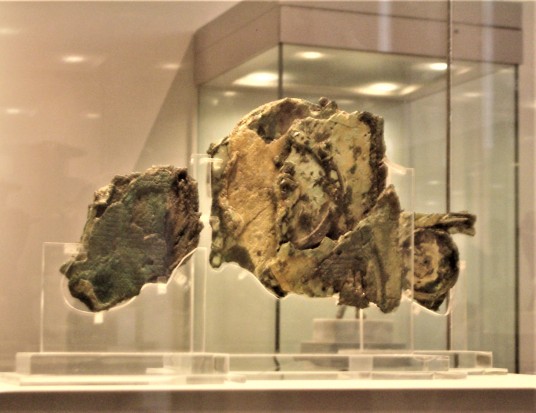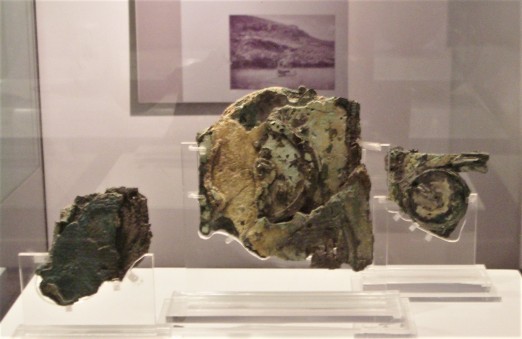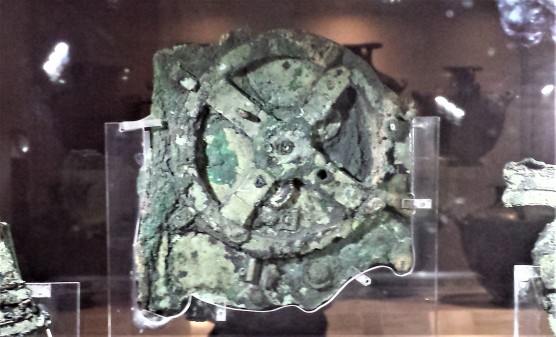Grove Koger
If it weren’t for the most extraordinary chain of chance, of fatally bad luck and incredibly good luck, no one outside of Greece would recognize the name Antikythera. No one.
Located on the western edge of the Aegean Sea between the larger island of Kythera and the northwestern tip of Crete, the islet (it’s less than 8 square miles in area) was the scene of an extraordinary discovery in 1901. The preceding year, a team of sponge divers had happened upon the site of an ancient shipwreck off its coast at a depth of about 180 feet. Wearing a diving suit and helmet and relying on air pumped down a hose, one of the divers was able to bring up the arm of a bronze statue that he had seen resting on the sea floor.

Upon being notified of the find, Greek authorities asked the divers to continue their work and sent naval ships to participate in the investigation, which was taken up again the following year. A number of artifacts were eventually recovered, among them several badly corroded lumps of metal. An archaeologist examining the fragments found that one of them contained a bronze gear wheel, but it was only decades later that X-ray examination revealed the presence of all or part of more than thirty such gears. Researchers eventually determined that the fragments had been part of a complex analogue computer capable of predicting the positions of the moon, the sun, and the five planets visible to the naked eye on any particular date. The mechanism would even have predicted solar and lunar eclipses.
Jacques Cousteau and his Calypso crew investigated the Antikythera shipwreck in 1953 and again in 1976, surveying the surrounding seabed and retrieving 300 or so additional artifacts. Then in 2012 the Woods Hole Oceanographic Institution, the Greek Navy and the Greek Ephorate of Underwater Antiquities pooled their resources to map the site and search for further artifacts. In 2014 the Hellenic Ministry of Culture and Sports initiated a multi-year project called Return to Antikythera to study the shipwreck and the site in even greater detail.

The ship lying off Antikythera is now estimated to have been about 130 feet in length, making it the largest ancient vessel ever discovered. It was probably on its way from a port in the Aegean to a settlement in Italy when it sank in a storm in about 60 BCE. However, the mechanism itself may date from as early as 205 BCE. It’s assumed that its inventor was Greek and may have lived on the island of Rhodes, although there are indications that he or she made use of astronomical and mathematical principles that had been developed much farther east, in Babylonia. It would be 15 centuries before similar inventions were again developed.
Scientists estimate that the bronze fragments recovered in the first years of the twentieth century represent less than half of the original mechanism, but although hundreds of artifacts have been discovered at the site since then, including a life-sized bronze statue, no further significant pieces of the computer itself have been found.
□□□
Want to know more? See Josephine Marchant’s Decoding the Heavens: A 2,000-Year-Old Computer—and the Century-Long Search to Discover Its Secrets (Da Capo, 2009) and the Antikythera Mechanism Research Project at http://www.antikythera-mechanism.gr/. There’s also a generous selections of videos on YouTube, including https://www.youtube.com/watch?v=O5_29GTY-ls&list=WL&index=4&t=1279s and https://www.youtube.com/watch?v=s8xVASJl8bw&list=WL&index=8&t=16s.
□□□
Maggie and I took the photos you see above in the National Archaeological Museum in Athens, where the major fragments of the Mechanism are displayed in acrylic cases.


I’ve also had the opportunity to write about the Antikythera Mechanism in two recent reference sets published by ABC-CLIO—The Sea in World History: Exploration, Travel, and Trade (2017) and The World’s Oceans: Geography, History, and Environment (2018).

